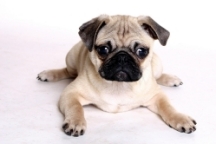
POINTS OF CONFUSION - Fawn
What colour is it really?
That is a very good question but one that is not so easy to answer. Fawn is a tricky one and poses quite a conundrum. You might be surprised at just how many different descriptions of the colour exist. Definitions range from solid light tan colours, to tan colours with a black mask, to dilute chocolate and more. To make matters even more complicated, they do not even seem to agree on the same genes. Here are a few.
MEDIUM TAN/BUFF: Some describe Fawn as being the cooler shades of tan, buff or light brown tones. This appears to be the generally accepted definition for the Fawn colour in the USA in the Havanese breed. There is not enough detail to know for certain whether this is intended to mean a sable with very little black [ A y ] or if it is meant to be a clear dog [ ee ]. The colour fawn in all AKC registrations is code # 082, however it must be noted that different breeds describe the colour in different ways.
 MEDIUM TAN/BUFF WITH MASK: For a number of well-established breeds, the fawn colour specifically refers to a dog of a medium shade of yellow/gold/beige colour that sports a definite black mask on the face and may also have dark coat on the dorsal spine, on the ears and tail tip. Familiar breeds are the fawn Great Dane and the fawn Pug. The mask gene is strong and widespread, the masked expression so common that it has become part of the defintion of Fawn in those breeds. It is interesting to note however that there are a small number of dogs that do not have a mask, these may be considered mismarked and may be referred to as no-mask Fawn. These breeds are generally considered to all be [ A y ]. The variance is in the presence or absence of a mask. [ E m ] or [ E ].
MEDIUM TAN/BUFF WITH MASK: For a number of well-established breeds, the fawn colour specifically refers to a dog of a medium shade of yellow/gold/beige colour that sports a definite black mask on the face and may also have dark coat on the dorsal spine, on the ears and tail tip. Familiar breeds are the fawn Great Dane and the fawn Pug. The mask gene is strong and widespread, the masked expression so common that it has become part of the defintion of Fawn in those breeds. It is interesting to note however that there are a small number of dogs that do not have a mask, these may be considered mismarked and may be referred to as no-mask Fawn. These breeds are generally considered to all be [ A y ]. The variance is in the presence or absence of a mask. [ E m ] or [ E ].
LIGHT SABLE: Yet others specify that a fawn coat is medium tone tan/beige/brown and can have dark hairs throughout and/or dark tipping. In this case the term fawn appears to be used to describe a sable that has very little dark coat. Some people call this clear sable, others call it fawn. Remember that a sable coat can range from nearly very pale colour to a strong gold/red and from almost monochrome colour with only a few black hairs to a large amount of black in the coat as interspersed single hairs and/or as heavy dark tipping. In this example, what is being looked as is [A y ] and the Fawn designation given to those that only have a small amount of dark coat.
CLEAR and SABLE: The FCI Havanese standard says ... fawn in its different shades (slight blackened overlay admitted). This description makes it sound as though the color fawn can be assorted shades of beige/buff/tan/gold with or without a dark overlay which would mean the name is a generic term that covers clear colours as well as sables. It is important to note that the FCI standard does not have cream, champagne or sable in its colour choices for the Havanese. The colour Fawn seems to cover all of them ranging through both the C gene and A gene as well as the E gene.
NOT AN OPTION: Where the FCI appears to use Fawn as a catch-all name for any light/medium colour based coat, other countries do not even list it as an option. Such is the case in Canada. The CKC registry has options for champagne and for sable but does not list Fawn as a colour choice for Havanese.
DILUTE CHOCOLATE: Throwing in yet another twist, still other breeds reserve the Fawn designation for the dilute chocolate dog with a pale brown coat and dilute pigment. [ bb dd ] In this case, the A gene is not even a consideration.
Is it any wonder Fawn is such a confusing colour? Regretfully I have no definitive answer. The best I can say is to look to the definition of the colour in your own country and registry. Keep these varied descriptions in mind when speaking to breeders and owners in other countries as you may not all be thinking of the same thing.
BACK ... Points of Confusion 9